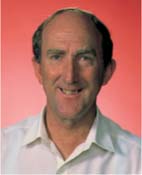T. Mark Florence
Graeme E. Batley AA Centre for Environmental Contaminants Research, CSIRO Energy Technology, Bangor NSW 2234, Australia (e-mail: graeme.batley@csiro.au).

|
Australian Journal of Chemistry 57(10) 899-902 https://doi.org/10.1071/CH04182
Submitted: 8 August 2004 Accepted: 8 August 2004 Published: 1 October 2004
This issue celebrates the lifetime scientific achievements of Mark Florence. Mark’s forty-five year research career was founded on chemistry, principally analytical chemistry, but encompassed the applications of chemistry to environmental, occupational hygiene, and health science. These are reflected in his extensive list of widely cited publications. This volume contains contributions from colleagues and associates with whom he interacted during his career.
Mark published his first paper, on a spectophotometric method for nickel, soon after joining the Chemistry Division of the Australian Atomic Energy Commission (AAEC) in 1957. Using one of the first cathode ray polarographs in Australia, he developed a method for uranium ore analysis, the beginning of a fascination with electroanalytical chemistry. He applied polarography to the analysis of lanthanides based on their complexation with azo dyes. The reduction mechanisms proved unusual and became the subject of an external Master of Science degree obtained from the University of Technology in Sydney.
During a two-year attachment at the Oak Ridge National Laboratory in the USA in 1967, Mark explored the use of voltammetry at graphite electrodes for metal analysis. He returned to AAEC to commence his pioneering research on anodic stripping voltammetry (ASV). He developed an in situ plated glassy carbon electrode, subsequently termed ‘the Florence electrode’, and his ASV methods for the determination of trace metals in natural waters were widely adopted. For his research achievements, Mark was awarded a Doctor of Science from the University of New South Wales, the first in analytical chemistry, in 1974.
Mark recognized the potential of ASV to measure only the labile fraction of metals in waters and exploited this in the measurement of metal speciation. He initiated research in ecotoxicology, in particular seeking to link chemical measurements of metal speciation to metal toxicity to algae.
By the 1980s, with a transfer to CSIRO, his interest in trace metal uptake by aquatic organisms was expanding to include the impacts of contaminants on humans. He developed and applied improved measurement techniques for human exposure to lead, manganese, aluminium, and polycyclic aromatic hydrocarbons. Of particular novelty was the demonstration of a new dermal uptake route for lead, through its measurement in sweat.
These studies led to an interest, from a chemical perspective, in the role of antioxidants in cancer and ageing, and later expanded to include human nutrition and natural medicine. His publication (with Russell Setright) in 1994 of The Handbook of Preventive Medicine, was the culmination of his journey through chemistry to toxicology and human health.
Mark achieved international recognition for his research, particularly in the areas of stripping voltammetry and metal speciation and bioavailability. His reputation attracted researchers from the USA, Sweden, Denmark, New Zealand, and China to his laboratory and involved invitations to visit fellow scientists in these and other countries. Many of these are represented as authors in this volume. They join with me in celebrating his achievements, while mourning his passing.



